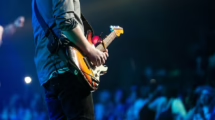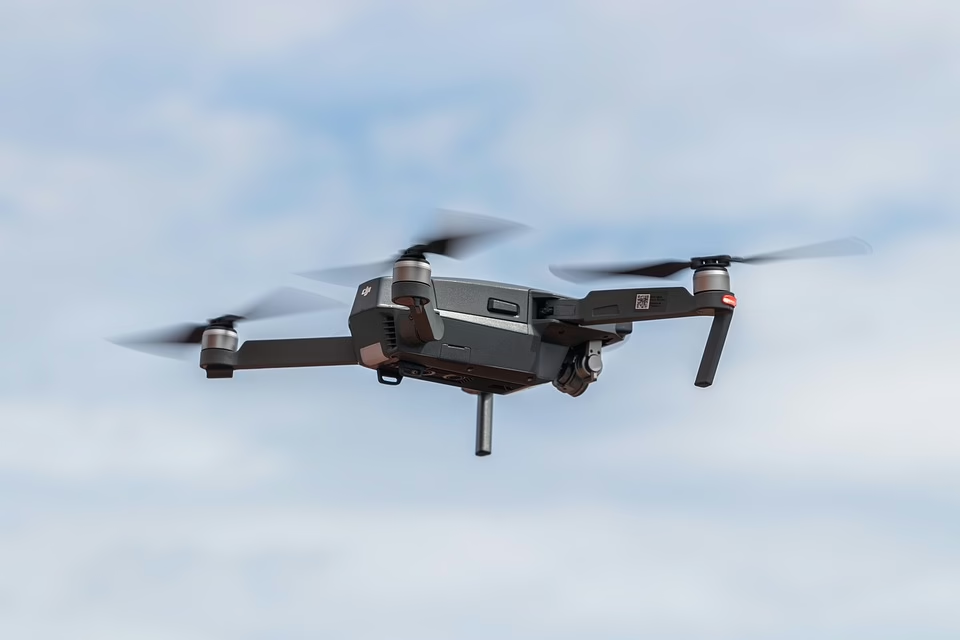ad_1]
Mechatronics Breakthroughs Fuel Next-Gen Drone Capabilities
Abstract: Drones, also known as unmanned aerial vehicles (UAVs), have rapidly evolved from simple remote-controlled aircraft to sophisticated platforms with applications spanning diverse fields such as agriculture, infrastructure inspection, delivery services, and search and rescue. This transformation is heavily reliant on advancements in mechatronics, an interdisciplinary field integrating mechanical engineering, electrical engineering, computer science, and control systems. This article explores the crucial role of mechatronics in driving the next generation of drone capabilities, focusing on key areas like enhanced propulsion systems, advanced sensor integration, intelligent control algorithms, miniaturization and power management, and novel actuation mechanisms. Furthermore, it delves into the impact of these mechatronic innovations on specific applications and future trends, highlighting the potential of drones to revolutionize various industries and shape the future of aerial technology.
Keywords: Mechatronics, Drones, UAVs, Propulsion, Sensors, Control Algorithms, Miniaturization, Power Management, Actuation, Robotics, Autonomy, Artificial Intelligence.
1. Introduction
The proliferation of drones over the past decade has been nothing short of revolutionary. Initially perceived as niche hobbyist toys, drones have matured into powerful tools capable of performing complex tasks across a wide range of sectors. This meteoric rise can be attributed to the convergence of technological advancements, particularly in the field of mechatronics [1]. Mechatronics, a synergistic blend of mechanical, electrical, computer, and control engineering, provides the foundation for the design, development, and operation of intelligent and automated systems [2]. In the context of drones, mechatronics enables the creation of robust, efficient, and adaptable platforms capable of navigating complex environments, collecting valuable data, and executing intricate maneuvers.
The early generations of drones were limited by their reliance on basic components and rudimentary control systems. They were often plagued by short flight times, poor stability, and limited payload capacity. However, breakthroughs in mechatronics have addressed these limitations, paving the way for a new era of drone capabilities. Enhanced propulsion systems offer greater efficiency and thrust, allowing for longer flight times and heavier payloads [3]. Advanced sensor integration provides drones with enhanced situational awareness, enabling them to navigate autonomously and avoid obstacles [4]. Intelligent control algorithms provide precise control over flight dynamics, allowing for stable flight even in challenging conditions [5]. Miniaturization and power management technologies have enabled the creation of smaller, more portable drones with extended battery life [6]. Finally, novel actuation mechanisms have expanded the range of tasks that drones can perform, from manipulating objects to performing complex inspections [7].
This article will delve into these specific areas of mechatronic innovation, exploring the underlying principles, technological advancements, and practical applications. It will also examine the impact of these advancements on various sectors, highlighting the potential of drones to transform industries and address critical challenges. Furthermore, the article will discuss future trends in mechatronics and drone technology, offering insights into the exciting possibilities that lie ahead.
2. Enhanced Propulsion Systems
A drone’s propulsion system is arguably its most critical component, directly impacting its flight time, payload capacity, and overall performance. Early drones relied on relatively inefficient brushed DC motors and simple propellers, resulting in limited endurance and lifting capabilities. Modern drones, however, benefit from significant advancements in motor technology, propeller design, and power electronics, all driven by mechatronic principles [8].
- Brushless DC Motors (BLDC): One of the most significant breakthroughs in drone propulsion is the widespread adoption of BLDC motors. Unlike brushed DC motors, BLDC motors utilize electronic commutation instead of mechanical brushes, resulting in significantly higher efficiency, longer lifespan, and improved power-to-weight ratio [9]. The intricate control of BLDC motors, achieved through sophisticated electronic speed controllers (ESCs), is a prime example of mechatronic integration. ESCs utilize feedback from motor sensors to precisely control the motor’s speed and torque, optimizing performance and efficiency. [10]
- Propeller Design: Propeller design has also undergone significant advancements, thanks to computational fluid dynamics (CFD) simulations and advanced materials. Optimized propeller designs maximize thrust while minimizing drag and noise. Factors such as blade pitch, airfoil shape, and tip geometry are carefully considered to achieve optimal performance for specific drone applications. Furthermore, the use of lightweight and high-strength materials, such as carbon fiber composites, further enhances propeller efficiency and durability. [11]
- Electric Ducted Fans (EDFs): While most drones utilize open propellers, electric ducted fans (EDFs) are gaining popularity in applications where stealth, safety, and maneuverability are paramount. EDFs encase the propeller within a duct, which improves aerodynamic efficiency and reduces noise. The design and control of EDFs require careful consideration of the interaction between the propeller and the duct, highlighting the importance of mechatronic optimization. [12]
- Fuel Cell Technology: While batteries remain the dominant power source for drones, fuel cell technology offers the potential for significantly longer flight times and higher energy densities. Fuel cells convert chemical energy directly into electrical energy, producing only water as a byproduct. The integration of fuel cells into drone propulsion systems requires sophisticated mechatronic solutions for fuel storage, fuel delivery, and power management. [13]
- Hybrid Propulsion Systems: Combining the benefits of both electric and internal combustion engines, hybrid propulsion systems can provide extended range and endurance. These systems often utilize a small internal combustion engine to generate electricity, which then powers electric motors driving the propellers. The complex control and coordination of these systems rely heavily on mechatronic principles. [14]
Example Application: Precision agriculture benefits significantly from enhanced drone propulsion systems. Drones equipped with long-endurance propulsion systems can survey large agricultural fields, collecting valuable data on crop health, irrigation needs, and pest infestations. This data can then be used to optimize agricultural practices, leading to increased yields and reduced environmental impact [15].
3. Advanced Sensor Integration
The ability of drones to perceive their environment and gather data is crucial for their autonomy and utility. Advanced sensor integration, another key area of mechatronics, enables drones to acquire a wide range of information, including position, orientation, velocity, altitude, and environmental conditions [16].
- Inertial Measurement Units (IMUs): IMUs are essential for determining a drone’s orientation and angular velocity. They typically consist of three accelerometers and three gyroscopes, which measure linear acceleration and angular rate, respectively. The data from the IMU is used by the flight controller to stabilize the drone and maintain its desired attitude. Modern IMUs are highly miniaturized and feature advanced signal processing algorithms to compensate for sensor drift and noise. [17]
- Global Navigation Satellite Systems (GNSS): GNSS, such as GPS, GLONASS, Galileo, and BeiDou, provide drones with precise positioning information. By receiving signals from multiple satellites, GNSS receivers can determine a drone’s latitude, longitude, and altitude. GNSS is crucial for autonomous navigation, waypoint following, and geofencing. However, GNSS signals can be unreliable in urban environments or indoors, requiring the use of alternative navigation methods. [18]
- Lidar (Light Detection and Ranging): Lidar sensors use laser light to create high-resolution 3D maps of the environment. By measuring the time it takes for laser pulses to return to the sensor, Lidar can determine the distance to objects with high accuracy. Lidar is used for obstacle avoidance, terrain mapping, and 3D modeling. [19]
- Cameras (RGB, Multispectral, Thermal): Cameras are versatile sensors that can capture visual information about the environment. RGB cameras capture color images, which can be used for visual inspection, object recognition, and scene understanding. Multispectral cameras capture images in multiple spectral bands, providing information about plant health, water content, and other environmental factors. Thermal cameras capture infrared radiation, allowing drones to detect temperature variations, which can be used for search and rescue operations or infrastructure inspection. [20]
- Ultrasonic Sensors: Ultrasonic sensors emit sound waves and measure the time it takes for the waves to return, providing information about the distance to nearby objects. Ultrasonic sensors are commonly used for obstacle avoidance in low-altitude environments. [21]
- Radar Sensors: Radar sensors emit radio waves and measure the time it takes for the waves to return, providing information about the distance, velocity, and direction of nearby objects. Radar sensors are particularly useful in adverse weather conditions, such as rain, fog, and snow. [22]
- Environmental Sensors: Drones can also be equipped with sensors to measure environmental parameters such as temperature, humidity, air pressure, and air quality. This allows them to be used for environmental monitoring and scientific research. [23]
Sensor Fusion: The integration of multiple sensors through sensor fusion techniques is crucial for achieving robust and reliable perception. Sensor fusion algorithms combine data from different sensors to create a more complete and accurate understanding of the environment. For example, data from an IMU and a GNSS receiver can be fused to improve positioning accuracy and compensate for GNSS signal outages. Similarly, data from a camera and a Lidar sensor can be fused to create a more detailed 3D map of the environment. [24]
Example Application: Infrastructure inspection is greatly enhanced by advanced sensor integration. Drones equipped with high-resolution cameras, thermal sensors, and Lidar can inspect bridges, power lines, and wind turbines, detecting cracks, corrosion, and other defects. This allows for proactive maintenance, reducing the risk of catastrophic failures [25].
4. Intelligent Control Algorithms
The ability of a drone to fly autonomously and perform complex maneuvers depends heavily on intelligent control algorithms. These algorithms utilize sensor data to estimate the drone’s state (position, velocity, orientation) and generate control commands to achieve desired flight objectives [26].
- PID Controllers: Proportional-Integral-Derivative (PID) controllers are widely used in drone flight control systems. PID controllers adjust the control output based on the error between the desired state and the actual state. They are relatively simple to implement and can provide stable and responsive flight control. [27]
- Model Predictive Control (MPC): MPC is a more advanced control technique that uses a mathematical model of the drone’s dynamics to predict its future behavior. MPC optimizes the control inputs over a future time horizon, taking into account constraints on the drone’s state and control inputs. MPC can provide improved performance compared to PID controllers, particularly in challenging flight conditions. [28]
- Adaptive Control: Adaptive control algorithms can adjust their parameters online to compensate for changes in the drone’s dynamics or environmental conditions. This is particularly useful for drones operating in uncertain or changing environments. [29]
- Reinforcement Learning (RL): RL is a machine learning technique that allows drones to learn optimal control policies through trial and error. RL can be used to train drones to perform complex tasks, such as autonomous navigation in cluttered environments or acrobatic maneuvers. [30]
- Computer Vision-Based Control: Using computer vision techniques, drones can interpret visual information to control their flight. This can include tasks such as following a target object, landing on a specific marker, or navigating through a visually complex environment. [31]
- Swarm Intelligence: Coordinating the flight of multiple drones in a swarm requires sophisticated control algorithms that can manage communication, collision avoidance, and task allocation. These algorithms often draw inspiration from natural swarm behaviors, such as those observed in flocks of birds or schools of fish. [32]
Flight Controller Hardware: The flight controller is the central processing unit of the drone, responsible for executing the control algorithms and managing the sensors and actuators. Modern flight controllers are typically based on powerful microprocessors and feature sophisticated real-time operating systems. Open-source flight controller platforms, such as ArduPilot and PX4, have fostered innovation and collaboration in the drone community. [33]
Example Application: Search and rescue operations benefit significantly from intelligent control algorithms. Drones equipped with autonomous navigation and obstacle avoidance capabilities can search large areas for missing persons, even in challenging terrain or adverse weather conditions. The use of computer vision allows drones to identify potential survivors and guide rescuers to their location [34].
5. Miniaturization and Power Management
The miniaturization of drone components and the efficient management of power are crucial for creating smaller, more portable drones with extended battery life. Mechatronic engineering plays a vital role in achieving these goals [35].
- Miniaturized Sensors and Actuators: Advances in microelectromechanical systems (MEMS) technology have enabled the creation of highly miniaturized sensors and actuators. MEMS accelerometers, gyroscopes, and pressure sensors are now commonly used in drone flight controllers. Miniaturized actuators, such as micro-motors and micro-pumps, are used in various drone applications, such as micro-robotics and drug delivery. [36]
- Lightweight Materials: The use of lightweight materials, such as carbon fiber composites, aluminum alloys, and polymers, is essential for reducing the weight of drones. These materials offer high strength-to-weight ratios, allowing for larger payloads and longer flight times. [37]
- Efficient Power Electronics: The efficiency of power electronics components, such as voltage regulators and motor drivers, is crucial for maximizing battery life. Modern power electronics utilize advanced switching techniques and optimized circuit designs to minimize power losses. [38]
- Battery Technology: Lithium-polymer (LiPo) batteries are the most common power source for drones, offering high energy density and relatively low weight. However, LiPo batteries have limitations in terms of energy density and lifespan. Research is ongoing to develop new battery technologies, such as solid-state batteries and lithium-sulfur batteries, that offer improved performance and safety. [39]
- Wireless Power Transfer: Wireless power transfer technology allows drones to be charged without the need for physical connectors. This can be particularly useful for drones operating in remote or inaccessible locations. [40]
- Energy Harvesting: Energy harvesting techniques allow drones to scavenge energy from their environment, such as solar energy, wind energy, or vibration energy. This can extend the flight time of drones and reduce their reliance on batteries. [41]
Thermal Management: As drones become more powerful and compact, thermal management becomes increasingly important. Efficient heat dissipation is essential for preventing overheating and ensuring the reliability of electronic components. Mechatronic solutions for thermal management include heat sinks, fans, and liquid cooling systems. [42]
Example Application: Delivery services benefit significantly from miniaturization and power management. Smaller, more portable drones can navigate urban environments more easily and deliver packages directly to customers’ doorsteps. Extended battery life allows for longer delivery routes and increased operational efficiency [43].
6. Novel Actuation Mechanisms
Beyond the traditional propeller-based propulsion systems, novel actuation mechanisms are expanding the range of tasks that drones can perform [44]. Mechatronic engineering plays a crucial role in the design, development, and control of these advanced actuation systems.
- Robotic Arms: Drones equipped with robotic arms can perform manipulation tasks, such as picking up and placing objects, tightening bolts, or performing inspections in confined spaces. The control of robotic arms on drones requires sophisticated algorithms that account for the drone’s dynamics and the payload’s weight. [45]
- Grippers and End-Effectors: Various types of grippers and end-effectors can be attached to drones to perform specific tasks. These can include suction grippers for picking up smooth objects, magnetic grippers for picking up metallic objects, and specialized tools for cutting, welding, or painting. [46]
- Morphing Wings: Morphing wing technology allows drones to change the shape of their wings in flight, optimizing their aerodynamic performance for different flight conditions. This can improve efficiency, maneuverability, and stability. [47]
- Variable Pitch Propellers: Variable pitch propellers allow drones to adjust the pitch of their propeller blades in flight, optimizing thrust and efficiency. This can improve performance in hover mode and forward flight. [48]
- Tiltrotor and Tiltwing Designs: Tiltrotor and tiltwing designs combine the vertical takeoff and landing capabilities of helicopters with the high-speed forward flight capabilities of airplanes. These designs require complex control systems to manage the transition between vertical and horizontal flight. [49]
- Tethered Drones: Tethered drones are connected to a ground station via a cable, providing a continuous power supply and data link. Tethered drones can be used for persistent surveillance, communications relay, and power delivery. [50]
Integration with AI and Machine Learning: The integration of artificial intelligence (AI) and machine learning (ML) is further enhancing the capabilities of novel actuation mechanisms. AI algorithms can be used to control robotic arms with greater precision and dexterity, while ML algorithms can be used to optimize the performance of morphing wings and variable pitch propellers. [51]
Example Application: Bridge inspection benefits from novel actuation mechanisms. Drones equipped with robotic arms and specialized sensors can access hard-to-reach areas of bridges, performing detailed inspections and identifying potential structural defects. This reduces the need for human inspectors to work in hazardous conditions [52].
7. Impact on Applications
The mechatronic breakthroughs discussed above have had a profound impact on a wide range of drone applications. Here are some examples:
- Agriculture: Precision agriculture, crop monitoring, irrigation management, pest control, yield estimation.
- Infrastructure Inspection: Bridge inspection, power line inspection, wind turbine inspection, pipeline inspection, building inspection.
- Delivery Services: Package delivery, medical supply delivery, food delivery, e-commerce.
- Search and Rescue: Locating missing persons, assessing disaster damage, delivering emergency supplies.
- Security and Surveillance: Perimeter security, border patrol, law enforcement, traffic monitoring.
- Construction: Site surveying, progress monitoring, safety inspection, equipment tracking.
- Mining: Mapping and surveying, stockpile monitoring, equipment inspection, safety monitoring.
- Environmental Monitoring: Air quality monitoring, water quality monitoring, wildlife monitoring, deforestation tracking.
- Film and Photography: Aerial photography, videography, cinematography, surveying for film sets.
- Scientific Research: Atmospheric research, geological surveys, archaeological surveys, biodiversity studies.
- Emergency Response: Disaster assessment, delivery of aid, communication relay, aerial firefighting.
8. Future Trends
The field of mechatronics is constantly evolving, and the future of drone technology is likely to be shaped by the following trends:
- Increased Autonomy: Drones will become increasingly autonomous, relying less on human intervention and more on sophisticated AI algorithms.
- Swarm Robotics: Swarm robotics will enable groups of drones to work together to perform complex tasks, such as search and rescue or infrastructure inspection.
- Edge Computing: Edge computing will allow drones to process data locally, reducing latency and improving real-time decision-making.
- 5G Connectivity: 5G connectivity will enable faster and more reliable communication between drones and ground stations, improving control and data transmission.
- Advanced Materials: The development of new materials, such as graphene and metamaterials, will enable the creation of lighter, stronger, and more efficient drones.
- Artificial Intelligence Integration: AI will be deeply integrated into all aspects of drone operation, from flight control and navigation to perception and decision-making.
- Human-Drone Interaction: More intuitive and natural interfaces will be developed for human-drone interaction, making it easier for humans to control and supervise drones.
- Regulations and Safety: Regulations and safety standards will continue to evolve to address the growing use of drones in various industries.
9. Conclusion
Mechatronics has been instrumental in driving the rapid evolution of drone technology. Breakthroughs in propulsion systems, sensor integration, control algorithms, miniaturization, power management, and actuation mechanisms have enabled the creation of versatile and capable platforms with applications spanning diverse fields. As mechatronics continues to advance, we can expect to see even more sophisticated and innovative drone capabilities emerge, transforming industries, addressing critical challenges, and shaping the future of aerial technology. The convergence of mechatronics, AI, and advanced materials will undoubtedly pave the way for a new era of autonomous and intelligent drones capable of performing tasks that were once considered impossible. Further research and development in these areas are crucial for realizing the full potential of drones and maximizing their societal and economic benefits.
References
[1] Bishop, R. H. (Ed.). (2002). Mechatronics handbook. CRC press. [2] Bolton, W. (2015). Mechatronics: Electronic control systems in mechanical and electrical engineering. Pearson Education. [3] Anderson, J. D. (2017). Fundamentals of aerodynamics. McGraw-Hill Education. [4] Baraniuk, R. G. (2007). Sensor networks. IEEE signal processing magazine, 24(4), 12-14. [5] Åström, K. J., & Murray, R. M. (2010). Feedback systems: an introduction for scientists and engineers. Princeton university press. [6] Madou, M. J. (2018). Fundamentals of microfabrication and nanotechnology. CRC press. [7] Siciliano, B., Khatib, O. (Eds.). (2016). Springer handbook of robotics. Springer. [8] Sadrmomtazi, A., Afjei, E., Delavar, M. A., & Menhaj, M. B. (2015). Optimal design of quadrotor PID controller using PSO algorithm. International Journal of Control, Automation and Systems, 13(3), 605-613. [9] Krishnan, R. (2017). Permanent magnet synchronous and brushless DC motor drives. CRC press. [10] Pillay, P. (Ed.). (2001). Modern electric, hybrid electric, and fuel cell vehicles: fundamentals, theory, and design. CRC press. [11] McCormick, B. W. (2016). Aerodynamics, aeronautics, and flight mechanics. John Wiley & Sons. [12] Seddon, J., & Plotkin, D. (2011). Basic helicopter aerodynamics. John Wiley & Sons. [13] Barbir, F. (2013). PEM fuel cells: theory and practice. Academic press. [14] Ehsani, M., Gao, Y., Emadi, A. (2018). Modern electric, hybrid electric, and fuel cell vehicles. CRC press. [15] Mulla, D. J. (2013). Twenty five years of remote sensing in precision agriculture: Key advances and challenges. Biosystems engineering, 114(4), 358-371. [16] Maybeck, P. S. (1979). Stochastic models, estimation, and control. Academic press. [17] Titterton, D. H., & Weston, J. L. (2004). Strapdown inertial navigation technology. IEE. [18] Hofmann-Wellenhof, B., Lichtenegger, H., & Collins, J. (2007). Global positioning system: theory and practice. Springer Science & Business Media. [19] Shan, J., & Toth, C. K. (Eds.). (2018). Topographic laser ranging and scanning: principles and processing. CRC press. [20] Lillesand, T., Kiefer, R. W., & Chipman, J. (2015). Remote sensing and image interpretation. John Wiley & Sons. [21] Kleeman, L. (2014). Simultaneous localization and mapping (SLAM) with ultrasonic sensors. Springer. [22] Skolnik, M. I. (2008). Introduction to radar systems. McGraw-Hill Education. [23] Vallero, D. A. (2014). Fundamentals of air pollution. Academic press. [24] Hall, D. L., & Llinas, J. (2001). An introduction to multisensor data fusion. Proceedings of the IEEE, 85(1), 6-23. [25] Washer, G. A., Fuchs, P. A., & Kramer, S. L. (2015). Nondestructive evaluation of civil infrastructure. Journal of Bridge Engineering, 20(12), 04015016. [26] Lewis, F. L., Dawson, D. M., & Abdallah, C. T. (1993). Robot control: theory and practice. Prentice Hall. [27] Bennett, S. (2011). A history of control engineering, 1930-1955. IET. [28] Rawlings, J. B., Mayne, D. Q., & Diehl, M. (2017). Model predictive control: theory, computation, and design. Nob Hill Publishing. [29] Narendra, K. S., & Annaswamy, A. M. (2012). Stable adaptive systems. Courier Corporation. [30] Sutton, R. S., & Barto, A. G. (2018). Reinforcement learning: An introduction. MIT press. [31] Corke, P. (2017). Robotics, vision and control: fundamental algorithms in MATLAB. Springer. [32] Bonabeau, E., Dorigo, M., & Theraulaz, G. (1999). Swarm intelligence: From natural to artificial systems. Oxford University Press. [33] Meier, L., Honegger, D., & Pollefeys, M. (2012). PX4: A modular framework for embedded flight control. Robot Operating System (ROS). [34] Murphy, R. R. (2014). Disaster robotics. MIT press. [35] Trimmer, R. W. (2012). Micromechanics and MEMS: classic and seminal papers to 1990. IEEE. [36] Gad-el-Hak, M. (2001). The MEMS handbook. CRC press. [37] Ashby, M. F. (2017). Materials selection in mechanical design. Butterworth-Heinemann. [38] Erickson, R. W., & Maksimovic, D. (2020). Fundamentals of power electronics. Springer. [39] Tarascon, J. M., & Armand, M. (2001). Issues and challenges facing rechargeable lithium batteries. Nature, 414(6861), 359-367. [40] Kurs, A., Karalis, A., Moffatt, R., Joannopoulos, J. D., Fisher, P., & Soljačić, M. (2007). Wireless power transfer via strongly coupled magnetic resonances. Science, 317(5834), 83-86. [41] Priya, S., & Inman, D. J. (2009). Energy harvesting technologies. Springer. [42] Incropera, F. P., DeWitt, D. P., Bergman, T. L., & Lavine, A. S. (2007). Fundamentals of heat and mass transfer. John Wiley & Sons. [43] Kaplan, J. M. (2017). The green capital of everyday life. Columbia University Press. [44] Spong, M. W., Hutchinson, S., & Vidyasagar, M. (2020). Robot modeling and control. John Wiley & Sons. [45] Niku, S. B. (2019). Introduction to robotics: analysis, control, applications. John Wiley & Sons. [46] Bullock, M. I. (2003). Handbook of robotic and automated manufacturing. Industrial Press. [47] Kota, S. (2018). Morphing aircraft. John Wiley & Sons. [48] Hepperle, M. (2006). Advanced aircraft design: conceptual design, analysis and optimization of subsonic civil airplanes. Butterworth-Heinemann. [49] Prouty, R. W., & Schwab, F. S. (2011). Helicopter performance, stability, and control. John Wiley & Sons. [50] Moore, S. D., & Flint, J. A. (2019). Tethered unmanned aerial vehicles (TUAVs): design, development, and applications. CRC press. [51] Russell, S. J., & Norvig, P. (2016). Artificial intelligence: a modern approach. Pearson Education. [52] Catbas, F. N., Susoy, M., & Frangopol, D. M. (2013). Condition assessment of highway bridges using structural health monitoring. Journal of Bridge Engineering, 18(7), 686-698.

























Add Comment